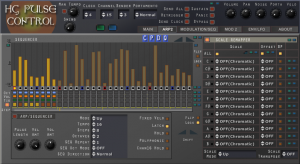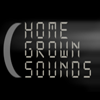
Pulse Control Page
ARP added - The existing ARP has now been replaced by the ARP/Sequencer from the HGSounds plugin 'ARP' which features:
- 32 Note Sequencer Mode - This has a 2 octave range, centre value represents actual note pitch.
Direction Modes - Forwards, Reverse, Alternate and Random Modes.
32 Note Muters - Basically a gate sequencer that decides if a note should play or not, can be used with the Sequencer or the Arpeggiator.
32 Note Tie - Allows tie-ing notes for classic analog style sequences, and even works in polyphonic mode for chord like effects.
Vol Row - This row can be used to select a set velocity for the step so can be used for accent, or alternatively a quieter note.
Octave Row - This Sequencer Row will decide whether a step uses the Octave rules selected via a popup menu. The rules range from standard +1 octave to cyclic which create an interesting flowing sequence.
1-4 Octaves - Once the ARP run is complete it will go up an octave as far as 4 Octaves.
Fixed Velocity Mode - can use a fixed Velocity instead of played velocity, which is set via a knob.
Latch Mode - Holds the note until the next one is played.
Pulse Width - When Latch is off, this determines how long the pulse is, affecting how long the note trigger is held.
Hold - This will hold any pressed keys until hold is depressed.
Scale Remapper- Allows changing the Scale on each note (C - B) so that a sequence can be squashed to the selected scale:
Over 70 scales to choose from.
Sequence Offset - This allows offsetting the start note of each sequence when it is triggered. For example in Poly Mode pressing 2 keys together will start both sequences running, one could be set to start on step 2 so that it will syncopate. In Monophonic mode it allows building more complex sequence patterns as they iterate.
Pitch Disable per note - This can prevent a sequence playing on the selected note, so that for example note C won't play the sequence but just C notes. This is useful in Polyphonic mode so that one key can be consistent whilst another note can play a sequence alongside it.
7 Scale Mapping Modes - The mode decides how the scale is altered, when a note doesn't match the scale, Up will select the next above, Down the next one down etc. There is also nearest, furthest and alternate. There is also a mode which holds the pitch of the octave, and simply uses the scale remapper to force the scale, useful for music without key changes.
Scale Remapper works with the OmiChorder even when the ARP/Sequencer is switched off.
Manual Tempo - Normal Operation is based on the Host Tempo so that it remains in sync with the project, however manual mode can be used in the fashion of an old analog sequencer.
Channel 16 Pitcher - When midi notes are sent to channel 16 the entire pitch of the plugin is transposed.
Copy/Paste - Can be used to copy a sequence to another preset including all rows.
Double/Quadruple - Double will copy the first 16 steps to the last 16 steps, Quadruple will duplicate the first 8 steps x 3.
Swing localised - Now Swing is used at all tempos in all sequencers (previously it only worked with 32 steps and relied on using master tempo to use at other tempos).


